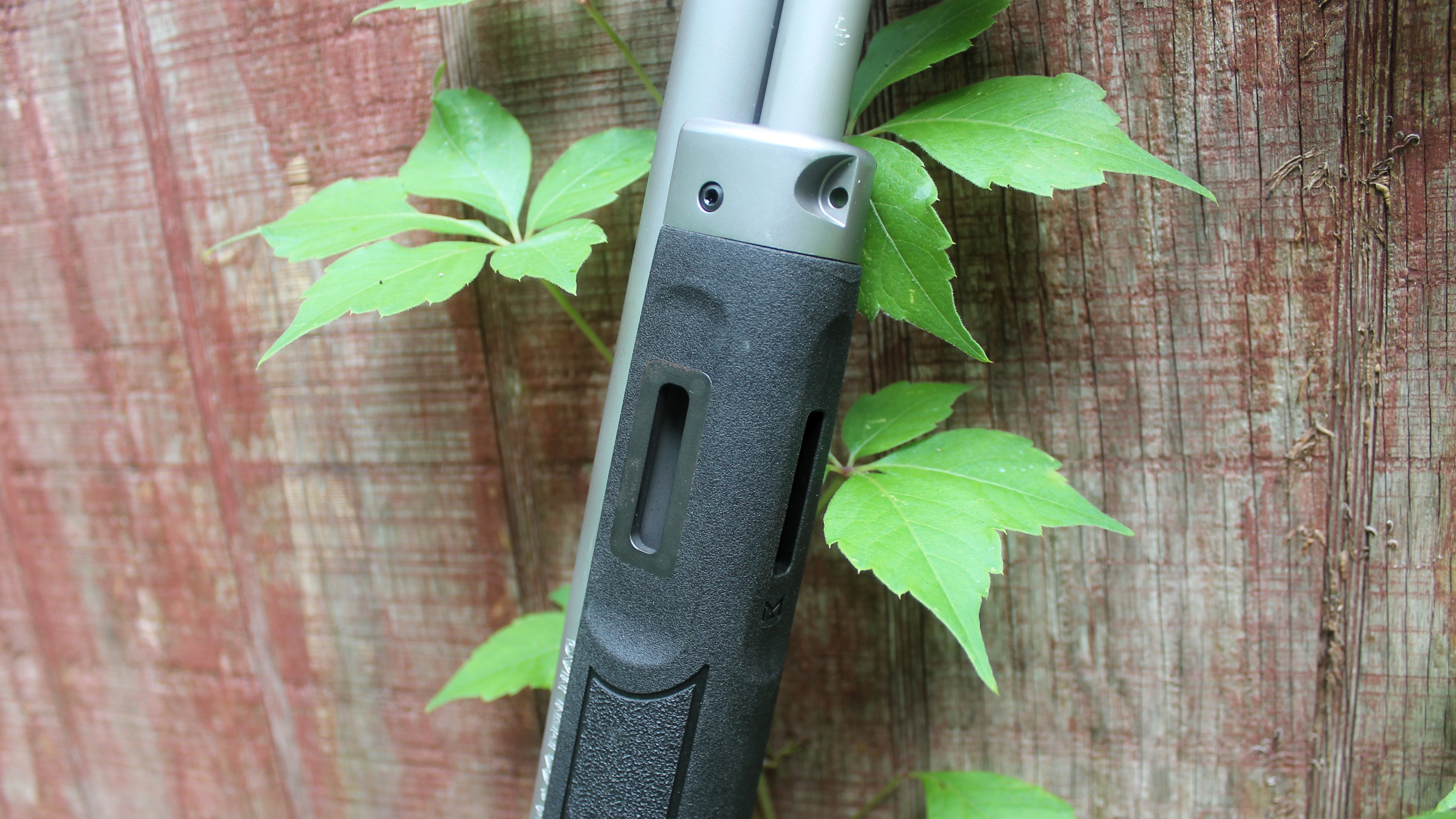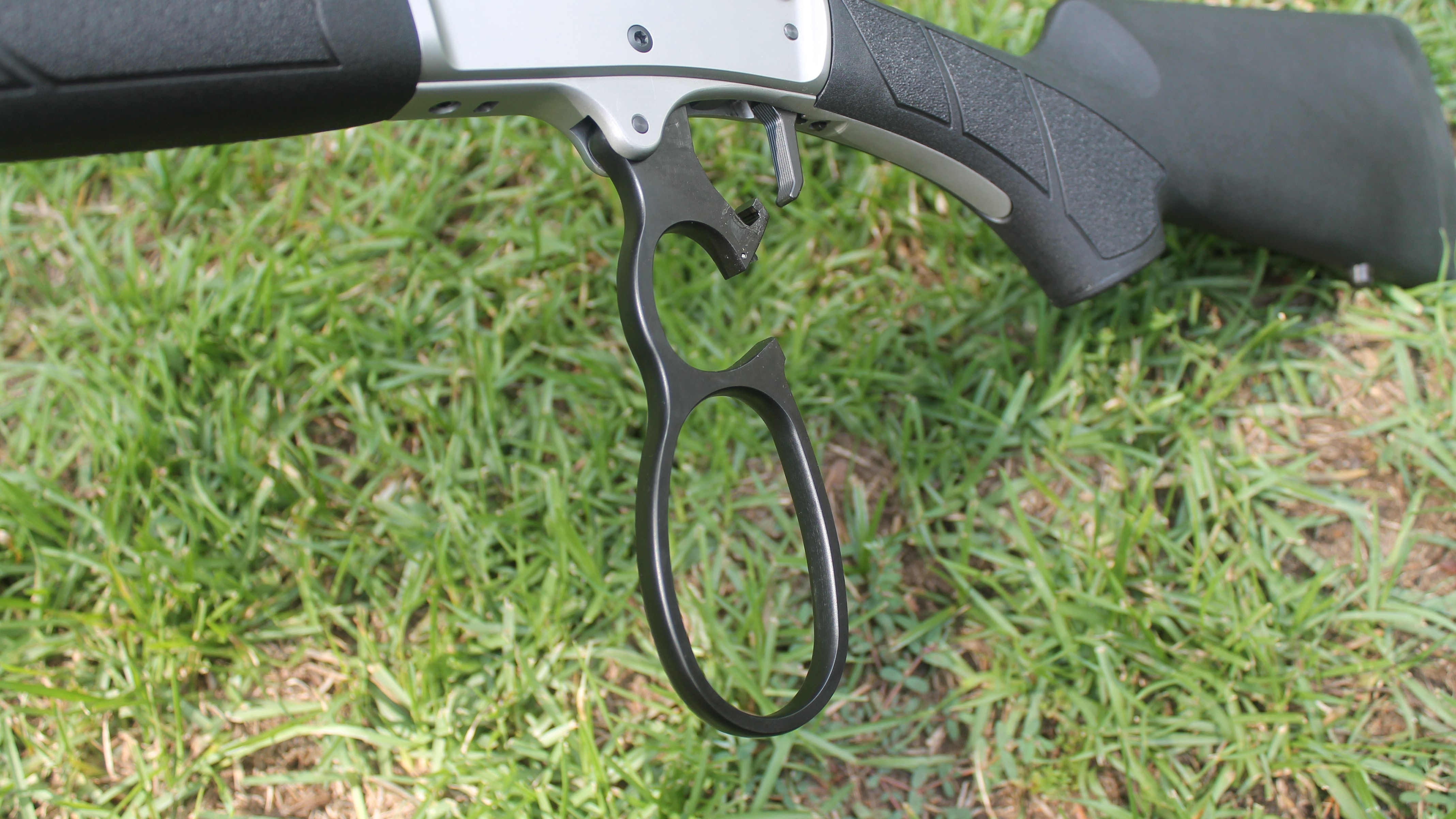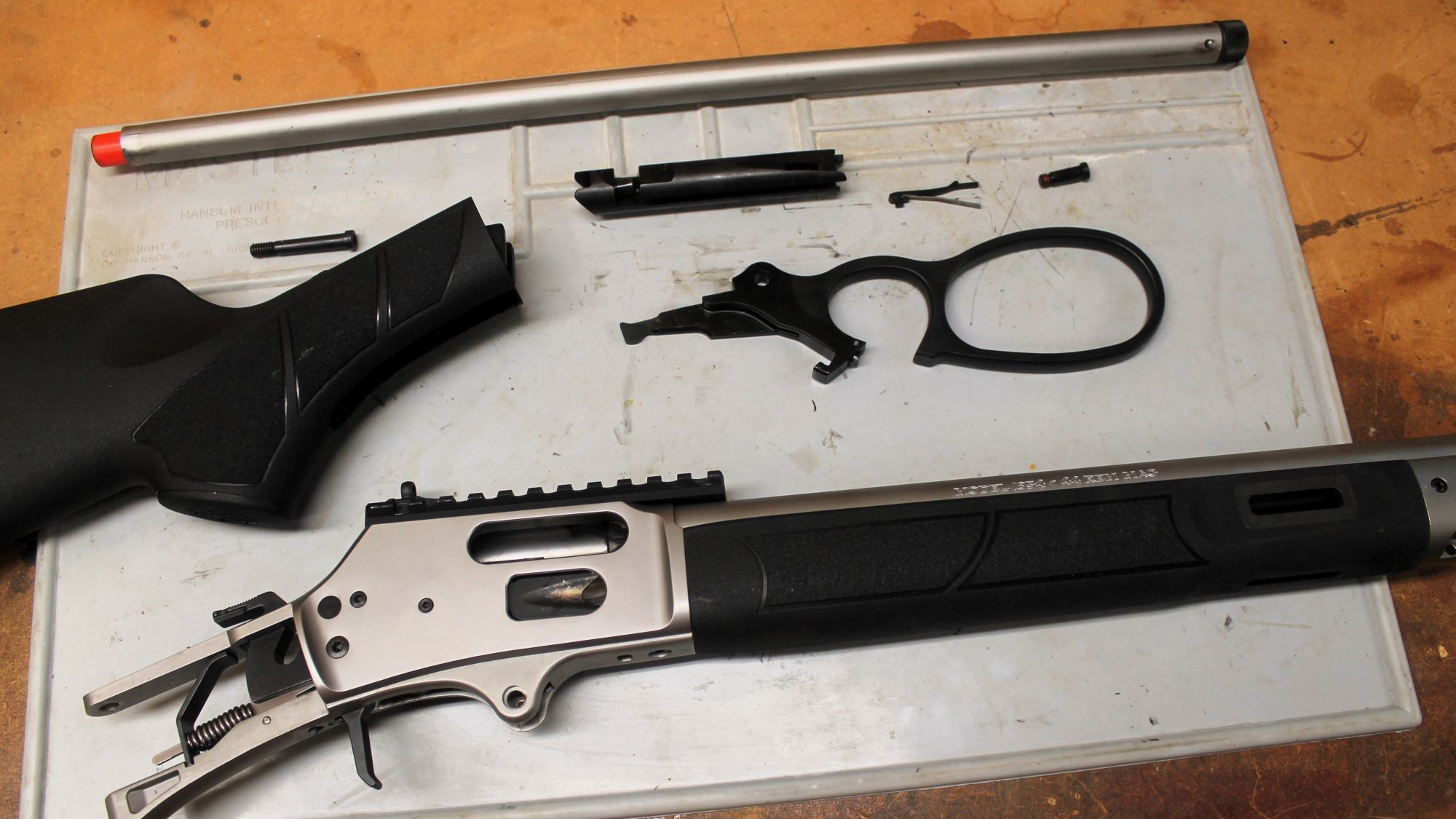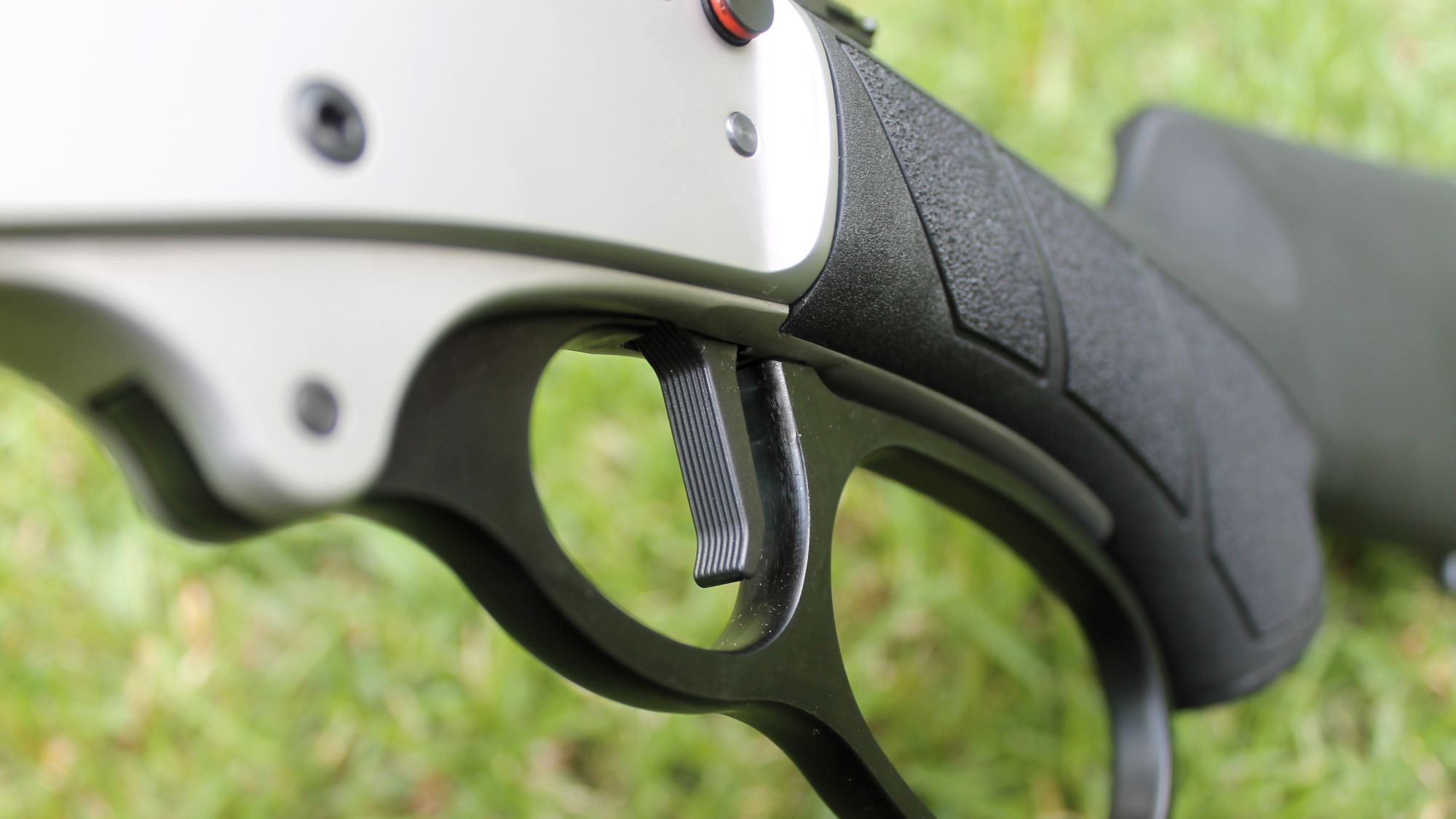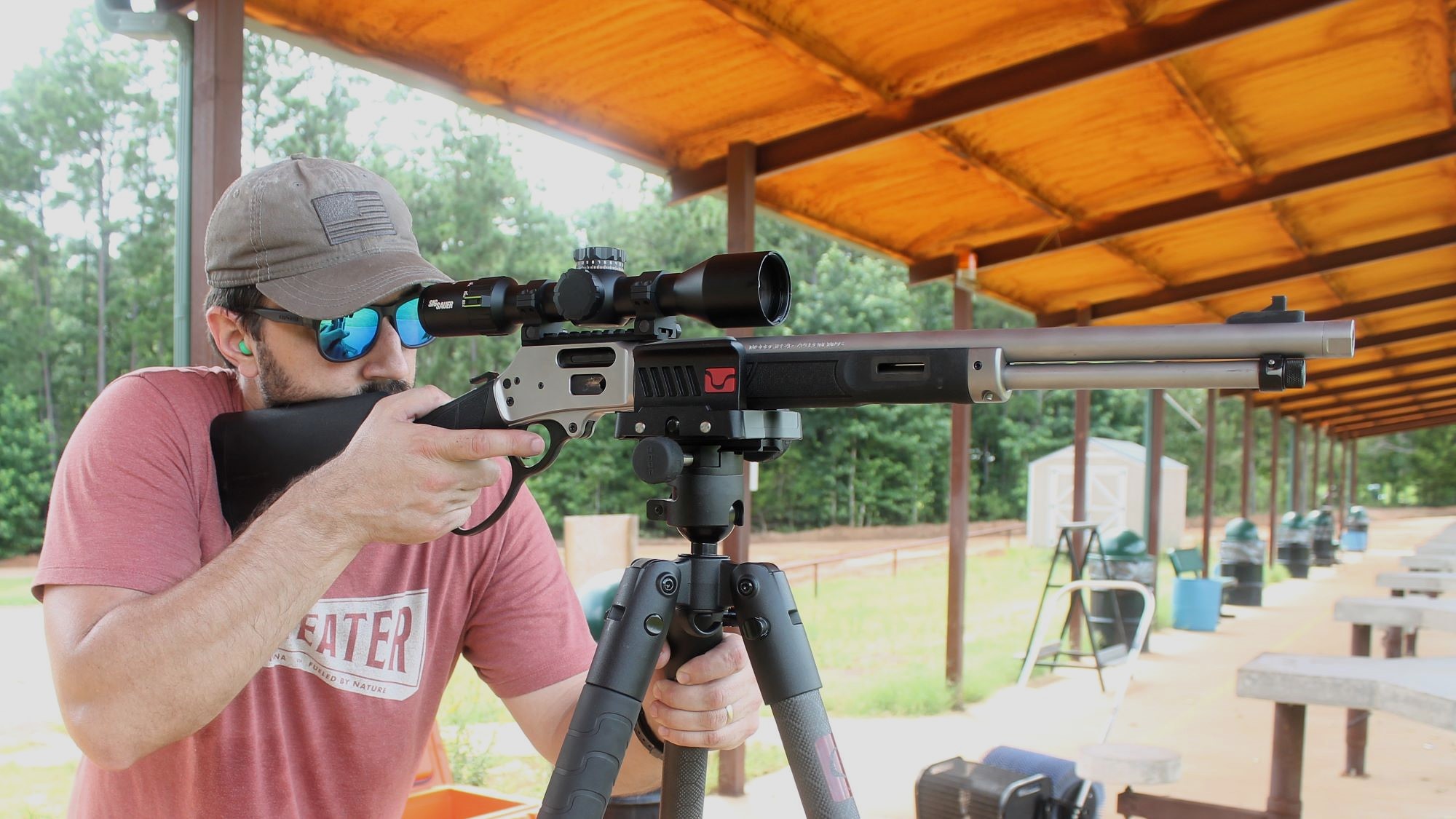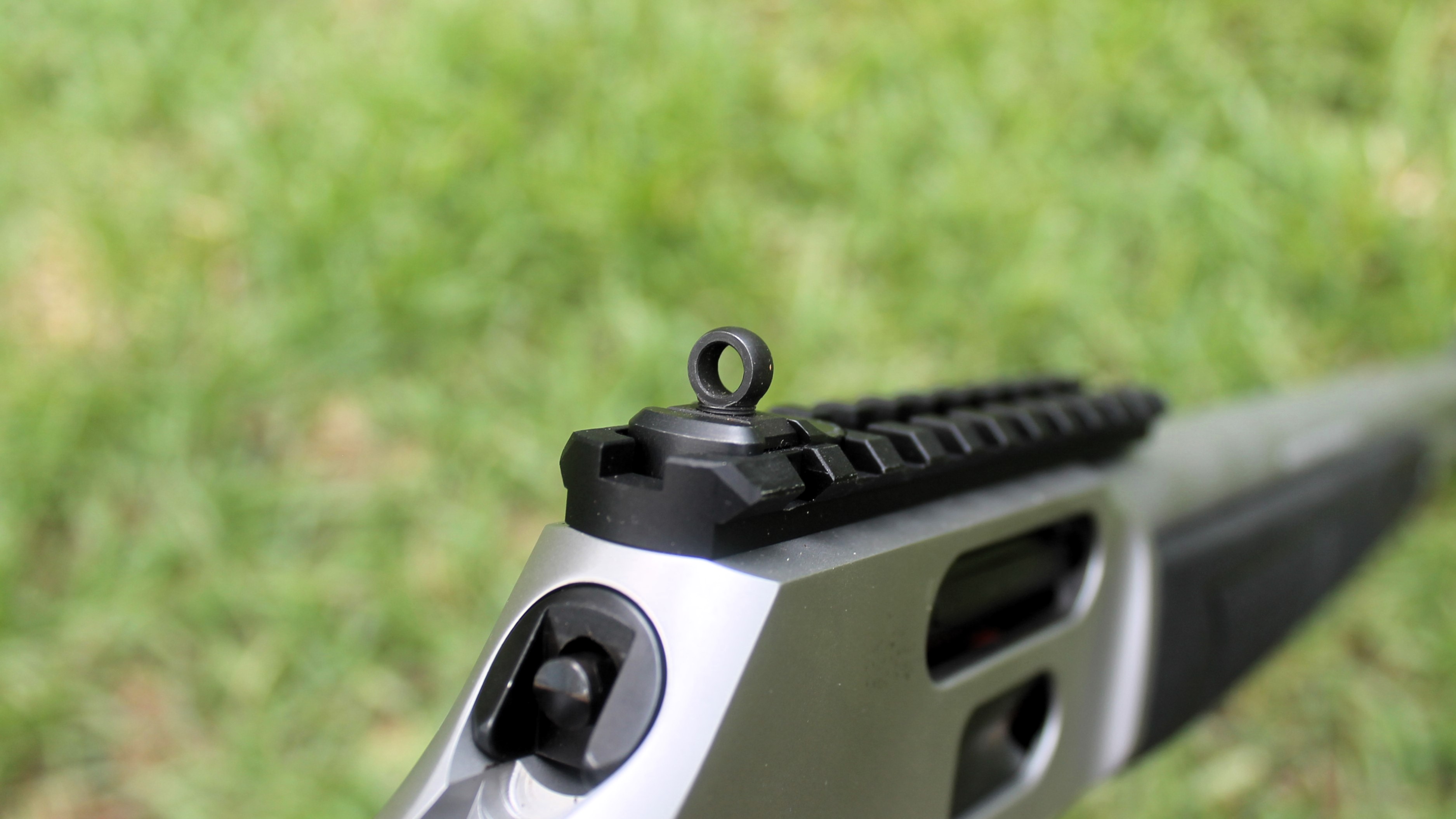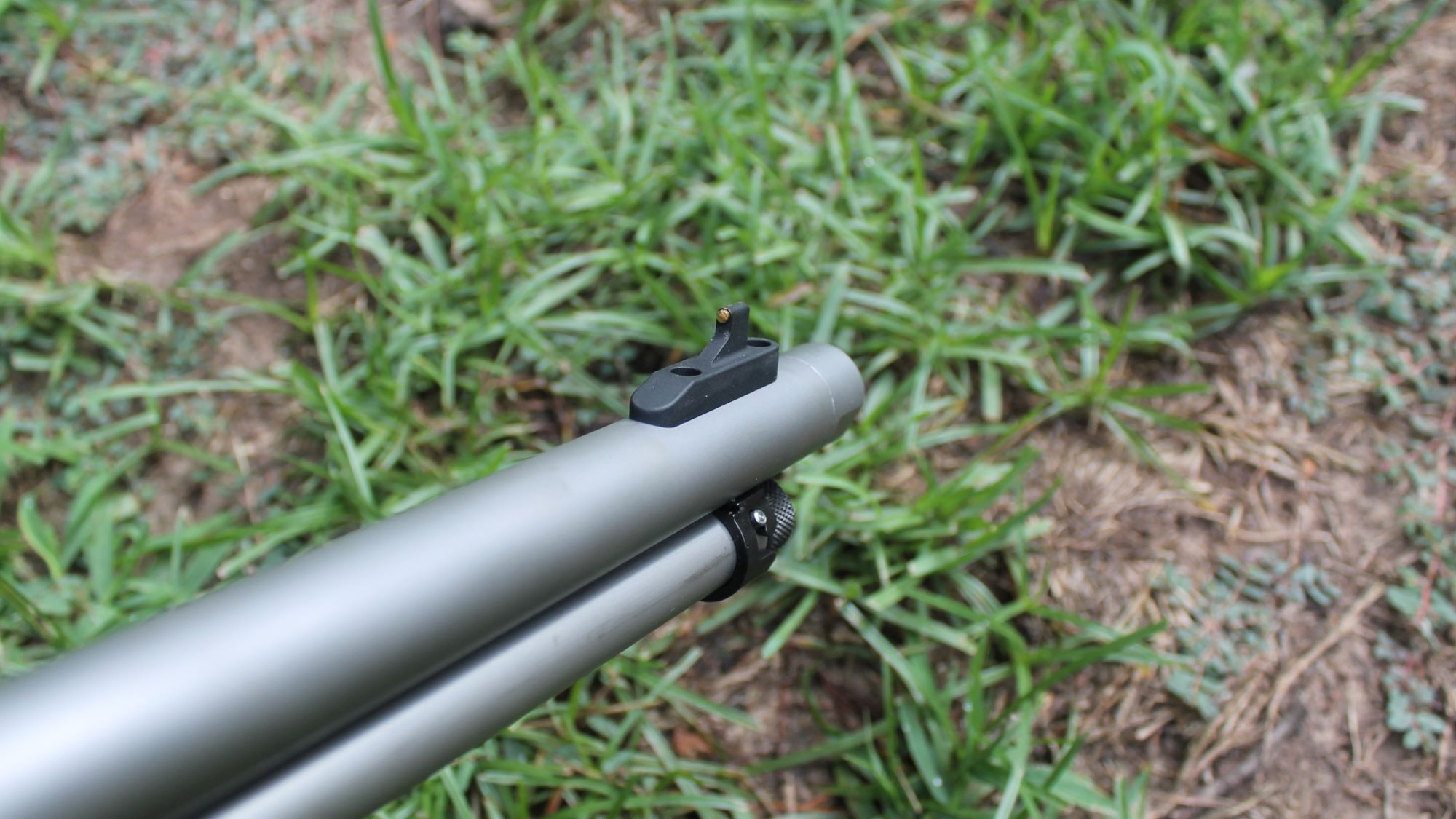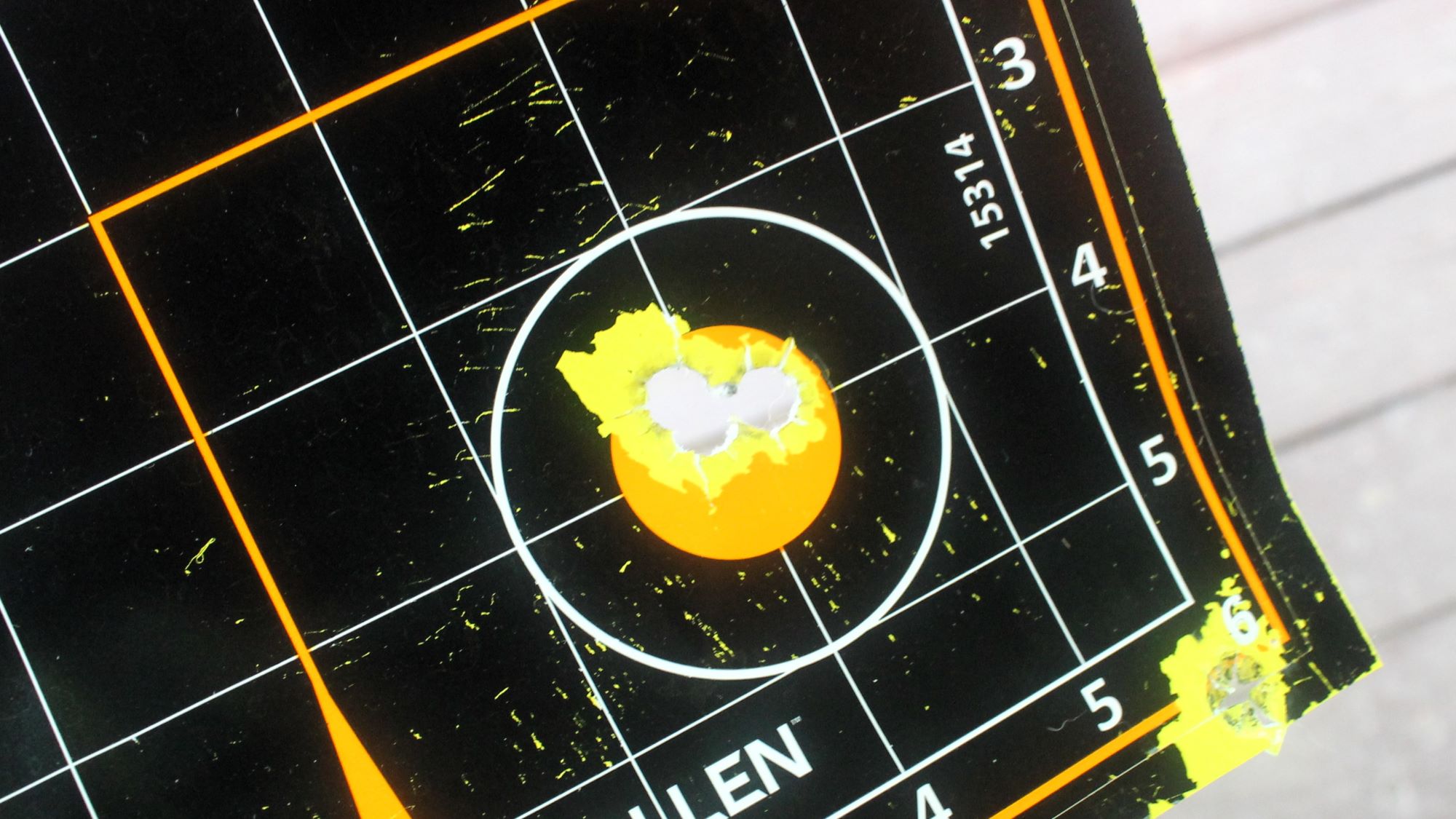Smith & Wesson has been around for nearly two centuries, so you might assume that the new Model 1854 is the resurrection of a much older lever gun. In fact, Smith’s new offering is the very first modern lever action rifle the company has ever produced, and it’s only been out for about a year.
“1854” refers not to the year the gun was initially released (as is the case with many of Winchester’s lever guns), but to the year Horace Smith and Daniel Baird Wesson released a different lever-action firearm, the Volcanic. The company says the Model 1854 is the culmination of that storied gunmaking heritage, and I was stoked to see another American company offering one of America’s most famous products.
Still, entering a new firearm category after 170 years is the ultimate test of that adage about old dogs and new tricks. The 1854 will have to compete with Ruger-made Marlins, Henrys, and Winchesters, all of which enjoy dedicated followings of lever gun aficionados. Only time will tell if the 1854 can break into this market, but in my experience with the rifle, it has a shot.

Pick Your Poison
The Model 1854 is a side-loading lever action that features an external hammer, cross-bolt safety, and medium-loop lever. Unfired cartridges can be unloaded by removing the tubular magazine, and the rifle can be had in 44 Magnum, 357 Magnum, 45 Colt, and 45-70 Govt.
The Traditional Walnut 1854 is fitted with a walnut stock while the Stealth Hunter 1854 is one of those blacked-out tactical situations you’ve heard so much about. The original Model 1854 combines those two aesthetics by mating a stainless steel barrel and receiver with black polymer furniture. All three models blend the old school with the new by featuring threaded barrels, ghost ring rear sights, and picatinny rails.
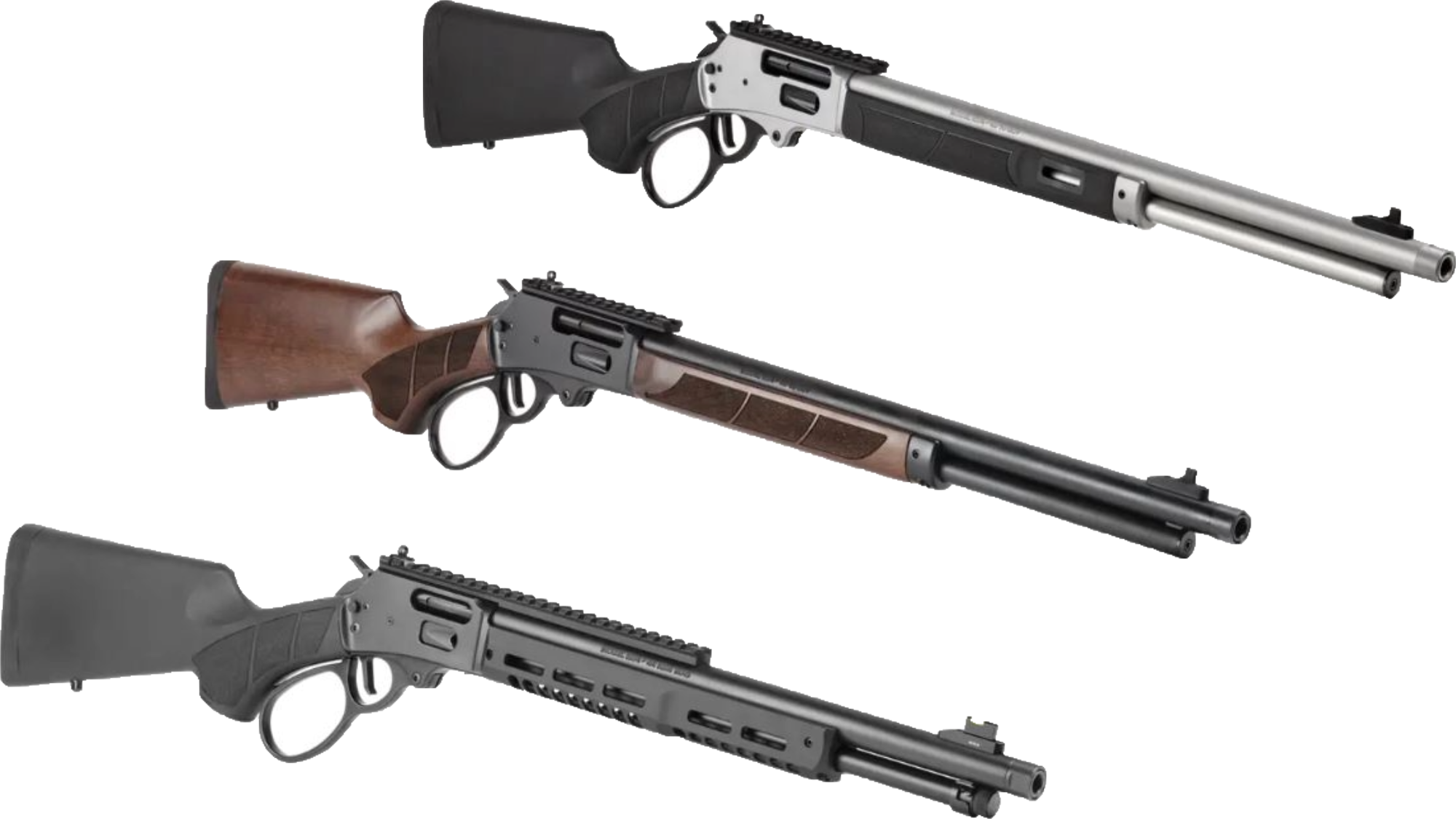
I used the original 1854 during the course of my testing, thanks to our friends over at Scheels. Here are some of its features and specs.
- 11/16-24 Threaded Barrel
- Accepts mounts compatible with Marlin® 1894 hole patterns
- Black synthetic stock with textured grip panels
- M-LOK® synthetic forend with textured grip panels
- Gold bead front sight
- XS Sights ghost ring rear sight
- 1:20″ RH Twist 8-Groove Rifling
- Large loop operating lever
- Forged 416 SS Receiver
- 19.25″ 410 SS Barrel
- 9-round capacity
- 6.8 pounds
- Available in 44 Magnum, 357 Magnum, 45 Colt, and 45-70 Govt.
- MSRP: $1279-$1499
Cross-Compatible Furniture
The furniture set that comes with this model of the 1854 is loaded with features but retains a tasteful, low-profile aesthetic.
First, the texturing is like a less aggressive skateboard tape. It’s rough enough to give you a firm purchase on the rifle but not so rough that it takes off a layer of skin.
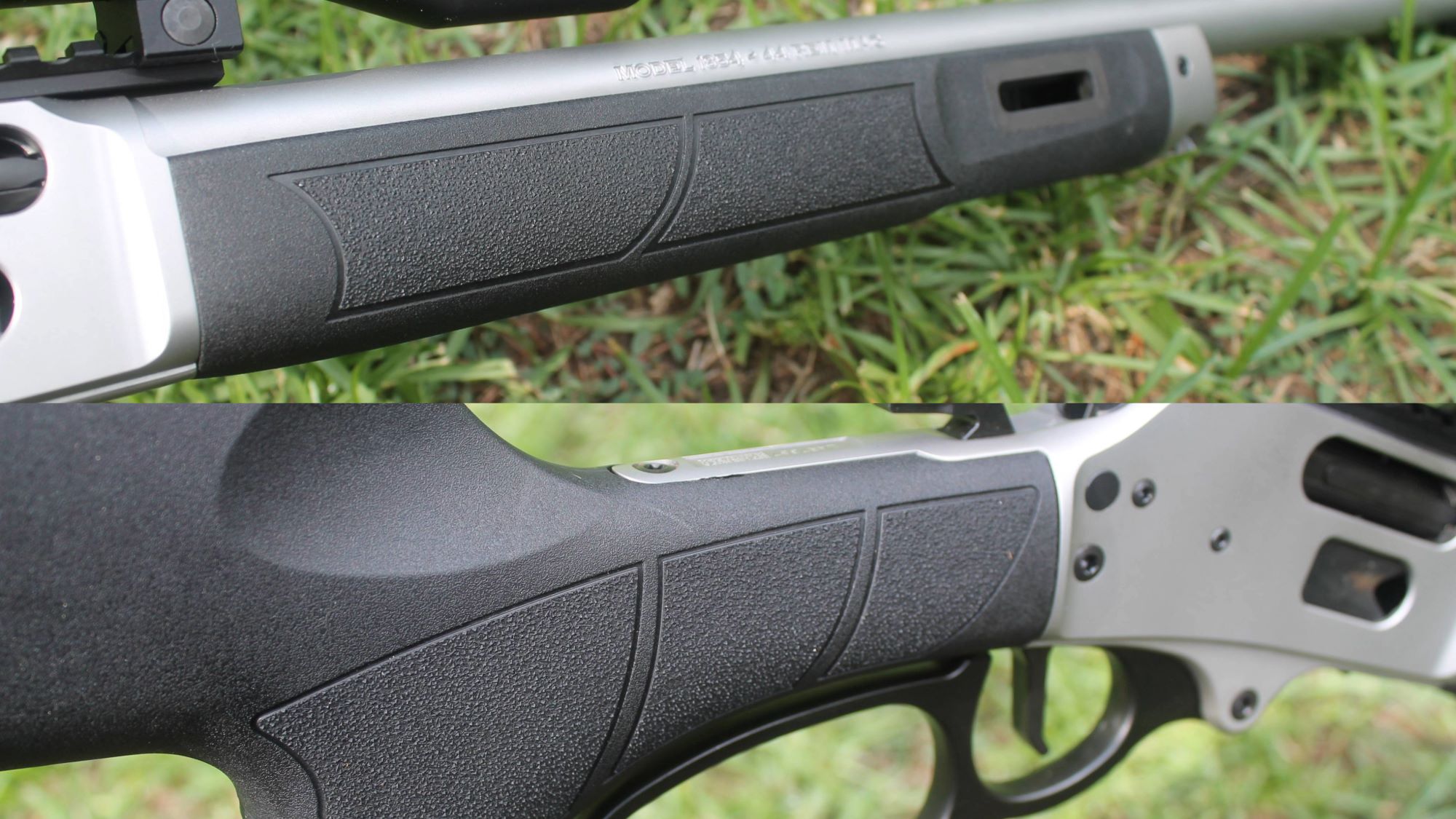
The stock features a healthy recoil pad to absorb the .44 Magnum, and the forend has M-LOK slots at the 3, 6, and 9 o’clock positions. That might not speak to many northern hunters, but here in the South, it’s nice to be able to affix a big green flashlight for hog hunting. I’ve seen lever gun hunters use duct tape to attach a flashlight to their rifles, but the 1854 offers a more elegant and secure solution.
I was also pleased to see that the 1854 can accept forends, stocks, and picatinny rails that use a Marlin Model 1894 pattern. All Model 1854’s come with a picatinny rail, but if for whatever reason you lose or damage it, you’ll likely be able to find a new one at your local gun store. And, if you want to swap out the polymer stock and forend with something more traditional, you can do that by finding furniture that fits an 1894. Good on Smith & Wesson for giving customers readily available aftermarket options rather than trying to fleece them for more money.
My only gripe is with the front sling stud. It works fine with most swivel sling attachments, but good luck attaching a bipod. The mechanism on the MDT hunting bipod I use has no hope of slotting into the recessed stud, and even though this Caldwell bipod can attach, it’s unstable because the stud is at the very front of the forend. The bipod has nothing to brace against forward of the stud, and so it can swing back and forth.
The best solution would be to use a bipod with M-LOK attachments or install a rail to one of those M-LOK slots. But if you don’t have a bipod that attaches to a rail or M-LOK, you’ll need to get one if you want to use it with the 1854.
“Smith & Wesson Smooth™”
Moving from how the gun looks to how the gun shoots, I was amused to see that Smith had legally claimed “Smith & Wesson Smooth™” and added it to every 1854 product description.
A company doesn’t trademark a catchphrase unless they’re confident it accurately describes their product (or, at least, they shouldn’t). Smith & Wesson calls the smoothness of the 1854 the rifle’s “standout feature,” and in a certain sense, they’ve put their money where their mouth is.
Problem is, “smooth” is subjective. A rusted action is obviously rougher than a new one, but there’s no objective standard that describes how it feels to run the lever. You might pick up an 1854 and be blown away by the action while some other fella might shrug and shake his head. Still, for what my opinion is worth, I’d put the 1854’s closer to “baby’s bottom” than “sandpaper” on the smoothness chart.
In fact, I have a hard time thinking back to a smoother side-loading lever gun straight from the box. It’s definitely slicker than this Marlin 336 I reviewed last year, though the action itself resembles a 336. The 1854 isn’t as smooth as Henry’s Lever Action Supreme, but Henry’s gun doesn’t have to work a lifter (the part that lifts a cartridge from the magazine). The 1854 must first raise a cartridge from the tubular magazine and then load it into the chamber, which introduces more opportunities for friction. So, while it may not be the absolute smoothest lever gun on the market, it’s definitely near the top of the list for similarly designed rifles.
I also had zero reliability issues as I put the 1854 through its paces. It never failed to feed or extract, and it went bang every time I pulled the trigger. That’s all you can really ask from a lever gun, and the 1854 delivers it.
The Trigger
Once you get a round loaded into the chamber, the trigger comes into play. All Model 1854’s come with a flat-faced trigger, which, in my opinion, is an odd choice for a lever gun. Some three-gun style competitive shooters prefer flat-faced triggers because they say they promote faster shooting in a semi-automatic platform. But while you can run a lever gun quickly, a flat trigger is unlikely to improve your split times.
It also looks out of place on the Traditional Walnut model. I don’t mind it on the Stealth Hunter or even the original, but it sticks out like a sore thumb alongside the beautiful walnut furniture. But that’s just my opinion.
I feel just as ambivalent about how the trigger functions. For a lever gun, it’s fine. It has some initial pre-travel that makes it feel like a double-action, but I don’t see anything in the marketing materials about that being intentional. Once you hit the wall, there’s a little more movement before the trigger breaks around five pounds. Again, it’s a fine trigger for a lever gun, and given a little practice, it won’t be the reason you miss.
At the Range
With a Sig Sauer WHISKEY6 mounted to the rail, an unloaded Model 1854 clocks in at 8 pounds 6 ounces. I think that’s the perfect weight for a rifle chambered in 44 Magnum. It’s heavy enough to absorb recoil and make this gun surprisingly pleasant to shoot, but not so heavy that you’d worry about taking it in the field.
That was exactly my experience during my trips to the range. Once I completed accuracy testing (more on that below), I was able to get up from the bench and use the 1854 as it was meant to be used. I shot from standing, seated, and other field positions, and I found that the gun was well balanced and came naturally to the shoulder. It also ran like a top. That smooth action shines in quick-shooting scenarios, and I ran through my supply of 44 Magnum more quickly than I would have liked.
If you prefer to go old-school and use irons rather than a magnified optic, Smith & Wesson has you covered. The rifle comes with an XS Sights ghost ring rear sight paired with a gold bead front sight. This isn’t a combination for precision work because the large ghost ring doesn’t offer a small enough point of reference to place the front sight in the same position every time. But for a quick shot on a deer or, God forbid, a charging grizzly, it’s exactly what you want.
If you do want to use the 1854 for precise shooting, be sure to do some accuracy testing to see what bullet it prefers. My testing revealed that this particular rifle seemed to like bullets on the heavier end of the 44 Mag. spectrum. I tested three cartridges, one from Federal and two from Hornady, and was very pleased with the results from the 270-grain HammerDown bullets. Those rounds averaged about 1.3-inch three-shot groups at 100 yards and produced several at or below the one-inch mark, including a clover-pattern 0.4-inch group. That group is admittedly an outlier, but it indicates that with a few tweaks at the reloading bench, the 270-grain HammerDown would be a solid performer.
| Ammo | Federal 270g Hammer Down | Hornady 240g XTP | Hornady 225g FTX |
| Average Group (in) | 1.32 | 2.66 | 5+ |
| Small Group (in) | 0.4 | 1.75 | N/A |
| Average Muzzle Velocity (fps) | 1693 | 1766 | 1755 |
| Average Muzzle Energy (ft-lbs) | 1721 | 1663 | 1540 |
I expected this rifle to produce groups in the 1.5-2-inch range, so I was less impressed with the 240-grain XTP and 225-grain FTX options from Hornady. I was especially surprised at the 225-grain LeveRevolution rounds because I’ve seen other reports that claim the Model 1854 shoots those the best. With this rifle, that was not the case. The shots were so erratic that I gave up trying to shoot individual groups and just fired 10 shots at the middle of a paper target. The “group” measured over five inches, and I use that term loosely.
I don’t know why I saw such a wide disparity between the consistency of one cartridge/bullet versus another. It’s not uncommon for rifles to prefer a particular combination, but usually the range isn’t so wide.
Still, I’m confident that you’ll be able to find something your 1854 likes. The 44 Mag was never a sniper round, so it doesn’t have to compete with a bolt-action chambered in a bottleneck cartridge. It just has to be consistent enough to hit a vital area out to about 200 yards, which is well within the wheelhouse of the 1854.
Last Shot
Smith & Wesson didn’t need to come out with a lever gun. I’m not privvy to their financials, but I’m sure they were doing just fine selling the revolvers, striker-fired handguns, and, more recently, AR-15s that have made them a household name. Their decision to jump into the lever-action market speaks to the continued popularity of the platform–and the demand from hunters and sport shooters for a new-school take on an old-school design.
It’s not perfect, and it’s certainly not alone, but I think the 1854 meets that need. It offers solid performance, slick features, and the cross-compatibility that allows users to make their gun their own. Plus, with prices hovering around $1200, it’s not out of reach for most hunters.
When it comes to lever actions, more options is never a bad thing, especially when those options are coming from a reputable company like Smith & Wesson. Check one out the next time you’re at your local gun store and you might just find that an old dog like S&W can learn a few new tricks after all.
Read the full article here


